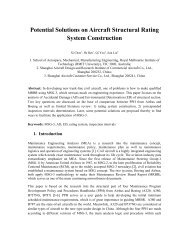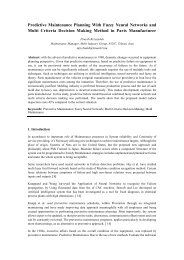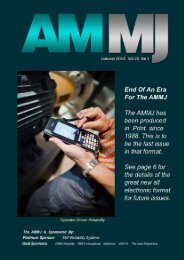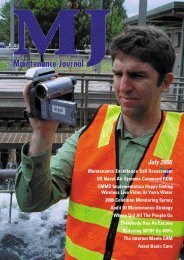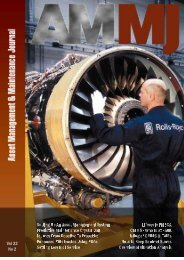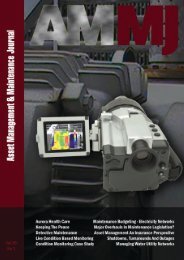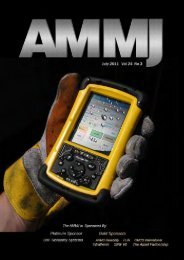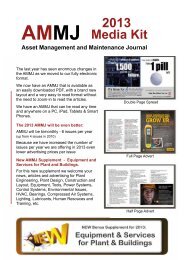Maintenance & Reliability News - Maintenance Journal
Maintenance & Reliability News - Maintenance Journal
Maintenance & Reliability News - Maintenance Journal
You also want an ePaper? Increase the reach of your titles
YUMPU automatically turns print PDFs into web optimized ePapers that Google loves.
8<br />
AMMJ<br />
July 2013<br />
Terry scanned the written information<br />
(getting feedback) on repairs made,<br />
delays encountered, and parts and tools<br />
used for each job.<br />
Terry also knew that separate daily<br />
timesheets each technician completed<br />
would be entered into the CMMS by a<br />
clerk and assign labor costs to each<br />
work order.<br />
Along with parts charged from the<br />
storeroom, the CMMS would total the<br />
cost for each work order.<br />
It was critical to have history cost<br />
information to help guide future repair or<br />
replace decisions.<br />
On one job it was not clear what extra<br />
part the technician had used. Terry<br />
paged the technician to ask him so the<br />
plan for a future job would have the part<br />
available.<br />
After making changes to several of the<br />
existing job plans in the CMMS (using<br />
feedback), Terry gave the paper work<br />
orders to the planning clerk to type the<br />
written feedback onto each work order<br />
in the CMMS, mark them as CLOSE,<br />
and then discard the actual paper<br />
copies.<br />
Time for the morning break. Things<br />
were going at a good pace.<br />
Not only was all the reactive work<br />
planned before lunch, but Terry had<br />
been able to close out the finished<br />
work orders and would get a start on<br />
planning the other work orders.<br />
After break, Terry concentrated on the<br />
“proactive” AUTH work orders in the<br />
CMMS.<br />
Two jobs required extensive<br />
maintenance planning and two jobs<br />
required only minimum maintenance<br />
planning. Terry printed out a copy of<br />
each proactive job for note taking.<br />
On the first extensive job, a<br />
thermography route (predictive<br />
maintenance) had shown a slight leak<br />
for a valve. A check of the CMMS<br />
history showed that this valve had a<br />
history of leaking.<br />
The second extensive job, for a<br />
pump, had no identified component<br />
tag number because schematics and<br />
coded tags were still being developed<br />
and hung for that section of the plant.<br />
Terry still looked around in the CMMS<br />
to see if he could find any past work<br />
orders under the general system code,<br />
but wasn’t able to find anything (system<br />
vs. component level).<br />
Of course, there wouldn’t be any<br />
history for the minimum maintenance<br />
jobs.<br />
Terry put on his hard hat and safety<br />
glasses and went out to scope the<br />
proactive work orders with a field<br />
check.<br />
He noted that although the valve was in<br />
somewhat of a high pressure service, it<br />
had flange connections and would not<br />
require a certified welder. Terry decided<br />
to include scaffolding in the plan.<br />
Terry then looked at the valve which<br />
was reported to be running hot. Terry<br />
was not sure what the solution to this<br />
would be.<br />
Go To Contents Page<br />
Go To Last Page




